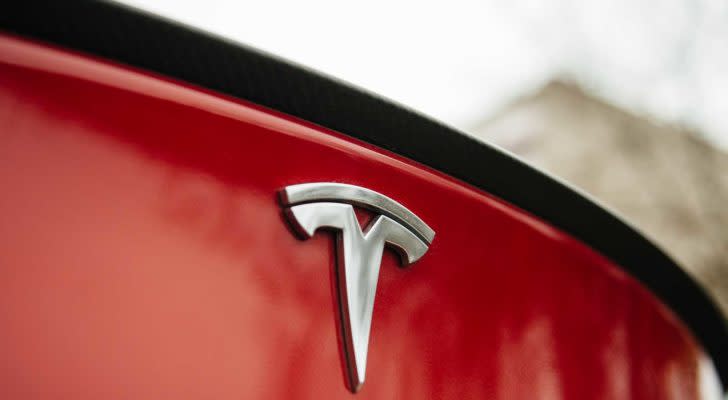You Should Be Concerned How Much Tesla Stock Can Move the S&P
This week, S&P Dow Jones Indices announced it will be ripping the Tesla (NASDAQ:TSLA) band-aid off. On Dec. 21, Tesla stock will be added to the S&P 500 index as by far the most valuable company ever.

Source: Hadrian / Shutterstock.com
The S&P 500 index is the most popular index of U.S. stocks. The SPDR S&P 500 ETF Trust (NYSE:SPY) is by far the largest ETF in the world by assets under management.
I am among many skeptics that believe Tesla is a great company but has a stock price that has been caught in a bubble for more than a year now. As an S&P 500 index ETF investor myself, I am concerned about the danger Tesla could pose to the S&P 500 once the bubble bursts.
InvestorPlace - Stock Market News, Stock Advice & Trading Tips
Tesla Stock and the S&P 500
The S&P 500 is a collection of 500 of the largest US-listed stocks. The index is market cap-weighted, meaning the formula used to calculate its price is based on the market caps of the component companies.
A stock’s weighting in the index is calculated by dividing a company’s individual market cap by the total market caps of all 500 companies in the index.
After gaining 785% in the last year, Tesla’s market cap is now around $550 billion. At its current valuation, Tesla is nearly three times larger than the largest stock ever added to the S&P 500.
The fact that Tesla’s valuation is so high yet it hasn’t been eligible for the S&P 500 until this year is extremely telling. Tesla needed to put together a string of four quarters of profitability to gain eligibility. After 17 years, it finally hit that profitability mark this year.
Investors have never valued an unprofitable company anywhere near the levels Tesla is valued now. Not Ford (NYSE:F) or General Motors (NYSE:GM) or any other auto stock in history. Not Amazon.com (NASDAQ:AMZN) or Netflix (NASDAQ:NFLX) or any other tech stock in history.
Tesla’s Initial Weighting
There’s a good chance Tesla could continue to rally to new highs between now and its Dec. 21 addition date. That rally would only add to the company’s bloated market cap. It could also potentially create even more problems with its inclusion.
However, for now let’s assume Tesla is added at a market cap of around $550 billion. It would immediately have the sixth-largest weighting in the S&P 500.
As an owner of the Vanguard 500 Index Fund ETF (NYSE:VOO) myself, here’s what that means for me. Overnight, I will go from having no part of Tesla in my portfolio to Tesla being my sixth-largest holding.
Here’s why that’s a problem. Back on May 1, Tesla CEO Elon Musk famously said “Tesla stock price is too high imo.”
I often disagree with Musk, but this time I think he got it right. Regardless, Tesla shares have skyrocketed another 317% in seven months since that tweet.
That price Musk said was “too high” now represents a split adjusted price of around $152. In other words, it represents about 74% downside from current levels. And remember, this is not the rantings of a crazy Tesla short seller. This is the price Musk himself said was too high earlier this year.
Back in September, I compared Tesla’s valuation to other auto stocks and high-growth tech stocks and arrived at a reasonable valuation of $141. That number is roughly in-line with the level Musk said was too high.
That level represents about 76% downside, so Musk and I seem to be on the same page. Tesla could easily have 70% to 80% downside when the bubble bursts. And before any Tesla bulls leave me angry comments about that target, remember I’m just agreeing with Musk.
How Much Could a Tesla Crash Hurt?
Tesla is a divisive stock. Plenty of people are believers and plenty of people are skeptics. But pretty much every American with money invested for retirement has significant exposure to the S&P 500. I want to know just how much the bursting of the Tesla bubble could hurt my VOO ETF investment.
The S&P 500’s total market cap is somewhere in the neighborhood of $32 trillion. Assuming Tesla would overshoot to the downside a bit if the stock crashes, how much of an impact would an 85% drop in Tesla’s share price have on the S&P 500 as a whole?
At current prices, 85% of Tesla’s market cap is worth about $460 billion. Crunching the numbers, $460 billion divided by $32 trillion is about 1.4%. So Tesla could potentially drag down the S&P 500 by around 1.4% all by itself.
Bigger Than Tesla
Of course, in reality the fallout of a Tesla stock crash would likely be much worse given the pain it would inflict on so many investors. There would certainly be ripple effects on other stocks.
I think there’s a good chance the S&P 500 inclusion will mark the ultimate top in Tesla stock for at least the next several years. However, as an S&P 500 index ETF investor, I’m hoping that top will simply mark the beginning of a decade of underperformance for Tesla rather than a volatile bubble-bursting event that could drag down the rest of the market.
On the date of publication, Wayne Duggan held long positions in GM and VOO.
Wayne Duggan has been a U.S. News & World Report Investing contributor since 2016 and is a staff writer at Benzinga, where he has written more than 7,000 articles. He is the author of the book “Beating Wall Street With Common Sense,” which focuses on investing psychology and practical strategies to outperform the stock market.
More From InvestorPlace
The post You Should Be Concerned How Much Tesla Stock Can Move the S&P appeared first on InvestorPlace.
